
Spending on B2B Google Ads is projected to reach significant levels this year. Specifically, B2B digital advertising expenditures in the U.S. are expected to grow to $19.22 billion in 2024, reflecting the increasing reliance on digital channels for marketing efforts. This surge in investment underscores the importance and effectiveness of Google Ads in driving business growth and achieving marketing objectives.
In this ultimate guide, we’ll delve into every aspect of creating and managing successful B2B Google Ads campaigns. Whether you’re a marketing agency looking to optimise your clients’ ads or a business aiming to enhance your advertising efforts, this comprehensive guide will equip you with the necessary knowledge and insights.
Outline
- What are B2B Google Ads?
- Benefits of B2B Google Ads for Businesses
- Setting Up a B2B Google Ads Campaign
- Understanding Keywords for B2B
- Crafting Compelling Ad Copy
- Utilising Ad Extensions
- Targeting the Right Audience
- Bidding Strategies
- Analysing Campaign Performance
- Optimising Your Campaign
- Leveraging Remarketing
- Budget Management
- Landing Page Optimisation
- Case Studies
- Common Mistakes to Avoid
- Advanced Strategies
- Integrating with Other Marketing Channels
- Compliance and Policies
- Future Trends in B2B Google Ads
- FAQs
- Conclusion
What are B2B Google Ads?
B2B Google Ads are tailored advertisements designed to reach businesses rather than individual consumers. These ads are displayed on Google’s search engine results pages (SERPs), as well as across its network of partner sites. The goal is to attract business clients who are actively searching for solutions, products, or services that your company offers. B2B Google Ads are particularly effective because they leverage Google’s extensive data and sophisticated targeting capabilities to connect with the right audience at the right time.
What are the key benefits of B2B Google Ads for Businesses?
Investing in B2B Google Ads can yield numerous benefits for businesses:
- Increased Visibility: Google Ads can significantly increase your brand’s visibility, placing your business in front of potential clients who are actively searching for your offerings.
- Targeted Reach: With advanced targeting options, you can ensure your ads are seen by the most relevant audience, improving the likelihood of conversions.
- Cost-Effective Marketing: Google Ads operates on a pay-per-click (PPC) model, meaning you only pay when someone clicks on your ad. This can lead to a higher return on investment (ROI) compared to traditional advertising methods.
- Measurable Results: Google Ads provides detailed analytics, allowing you to track the performance of your campaigns and make data-driven decisions to optimise your advertising strategy.
How to Set Up a B2B Google Ads Campaign
Before you can start running B2B Google Ads, you’ll need to set up a Google Ads account. This process involves several steps:
- Sign Up: Go to the Google Ads website and sign up for an account. You’ll need a Google account to get started.
- Set Your Budget: Determine your daily budget for your ads. This budget will dictate how much you’re willing to spend each day on your campaign.
- Choose Your Target Audience: Specify the geographic location, language, and other demographics of the audience you want to reach.
- Select Your Keywords: Keywords are the terms and phrases that will trigger your ads to appear in search results. It’s crucial to choose keywords that are relevant to your business and the products or services you offer.
- Create Your Ad: Craft a compelling ad that includes a headline, description, and call-to-action. Your ad should clearly convey the value proposition of your business.
- Set Your Bids: Decide how much you’re willing to pay for each click on your ad. You can choose between manual and automated bidding strategies.
- Launch Your Campaign: Once everything is set up, you can launch your campaign and start reaching potential clients.
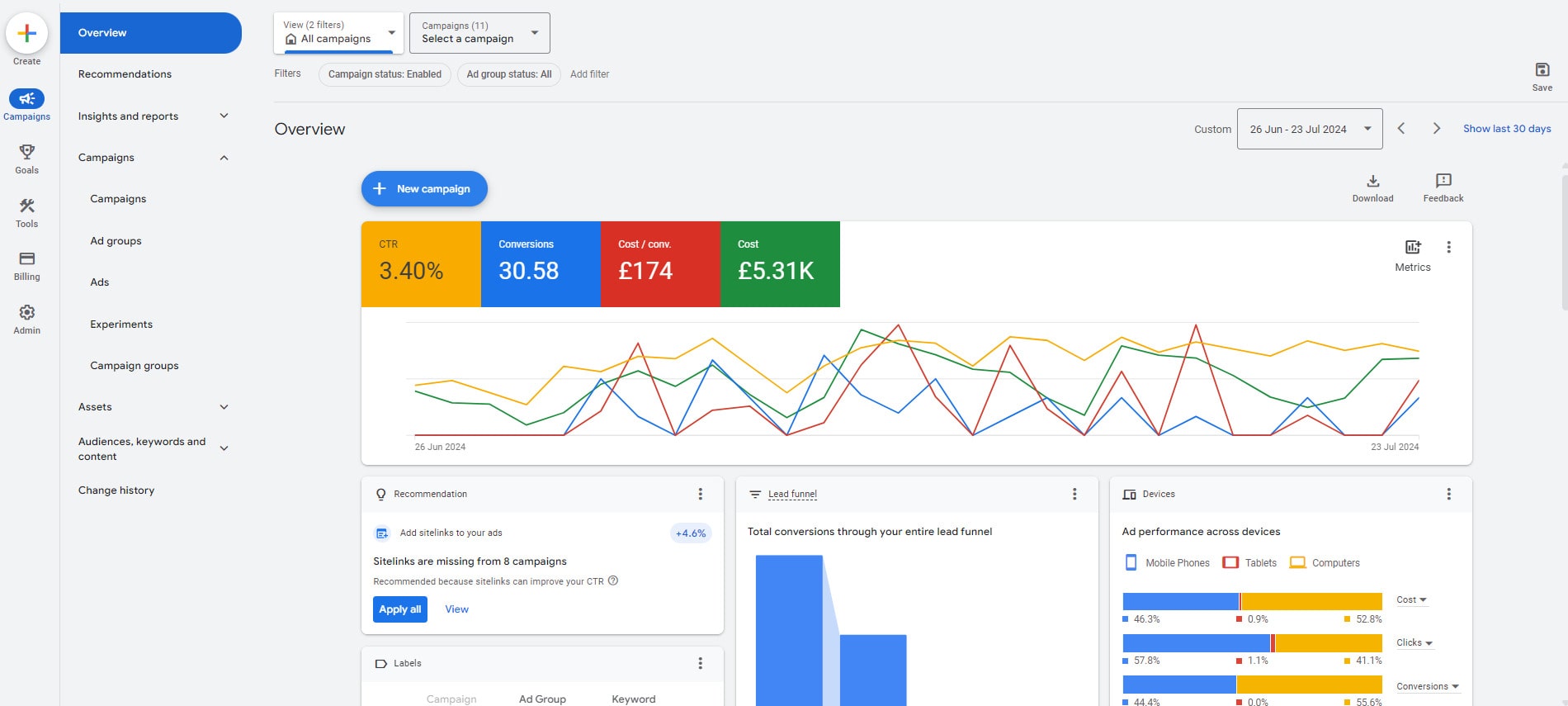
How to Choose the Right Keywords for B2B
In B2B Google Ads, choosing the right keywords is crucial. Long-tail keywords, which are longer and more specific phrases, are particularly effective for B2B campaigns. These keywords tend to have lower search volumes but higher conversion rates because they target users who are closer to making a purchasing decision. For example, instead of using a broad keyword like “marketing services,” a long-tail keyword might be “B2B marketing services for tech companies.”
Using long-tail keywords helps ensure that your ads are seen by a highly targeted audience, reducing wasted ad spend and increasing the likelihood of conversions.
Tips for Creating Compelling Ad Copy
Creating compelling ad copy is essential for capturing the attention of your target audience and encouraging them to click on your ad. Here are some best practices for writing effective B2B ad copy:
- Highlight Unique Selling Points (USPs): Communicate what sets your business apart from competitors.
- Use Action-Oriented Language: Encourage users to take action with strong verbs like “discover,” “learn,” “get,” or “start.”
- Include Numbers and Statistics: Specific numbers can make your ad more credible and appealing. For example, “Increase your ROI by 30% with our marketing services.”
- Address Pain Points: Identify common challenges your target audience faces and explain how your product or service can solve these issues.
- Create a Sense of Urgency: Phrases like “limited time offer” or “get started today” can motivate users to act quickly.
How to Utilise Ad Extensions
Ad extensions are additional pieces of information that expand your ad and provide users with more reasons to click. Google offers several types of ad extensions, each serving a unique purpose:
- Sitelink Extensions: Direct users to specific pages on your website, such as product pages or contact forms.
- Call Extensions: Display your phone number, making it easy for potential clients to call you directly from the ad.
- Location Extensions: Show your business address, helping users find your physical location.
- Callout Extensions: Highlight key benefits or features of your product or service.
- Structured Snippet Extensions: Provide a list of specific aspects of your products or services, such as types, categories, or brands.
Using ad extensions can improve your ad’s visibility and click-through rate (CTR), ultimately leading to more conversions.
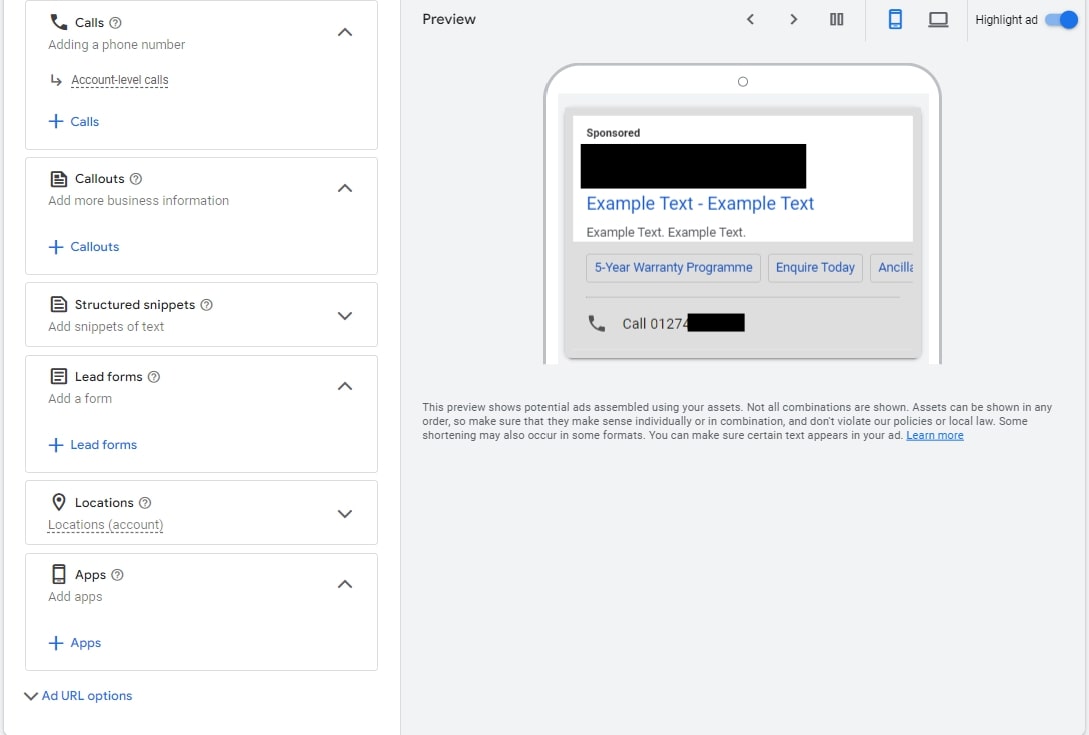
How to Target the Right Audience
Effective audience targeting is crucial for B2B Google Ads campaigns. Audience segmentation allows you to divide your target market into distinct groups based on specific criteria, such as industry, company size, job title, or behaviour. By tailoring your ads to these segments, you can deliver more relevant messages that resonate with your audience.
For example, you might create different ads for small businesses and large corporations, each highlighting the benefits most relevant to that segment. This approach increases the likelihood of engagement and conversions.
What the Google Ads Main Bidding Strategies?
Choosing the right bidding strategy is essential for maximising the performance of your B2B Google Ads campaign. There are two primary types of bidding strategies:
- Manual Bidding: This allows you to set specific bid amounts for your keywords. This gives you more control over your ad spend but requires ongoing management and optimisation.
- Automated Bidding: Uses Google’s machine learning algorithms to adjust your bids in real time based on various factors, such as competition and user behaviour. Automated bidding can save time and improve performance, but it offers less control than manual bidding.
Both strategies have their advantages and should be chosen based on your specific goals and resources.
How to Analyse Campaign Performance
To ensure your B2B Google Ads campaign is effective, it’s important to analyse its performance regularly. Key metrics to track include:
- Click-Through Rate (CTR): The percentage of users who click on your ad after seeing it. A high CTR indicates that your ad is relevant and engaging.
- Conversion Rate: The percentage of users who complete a desired action, such as filling out a form or making a purchase. This metric measures the effectiveness of your ad in driving conversions.
- Cost Per Click (CPC): The average amount you pay for each click on your ad. Monitoring CPC helps you manage your budget and optimise your bids.
- Return on Ad Spend (ROAS): The revenue generated from your ads is divided by the amount spent. ROAS measures the overall effectiveness and profitability of your campaign.
- Impressions: The number of times your ad is shown. While impressions alone don’t indicate success, they provide context for other metrics.
Regularly reviewing these metrics allows you to identify areas for improvement and make data-driven decisions to enhance your campaign’s performance.
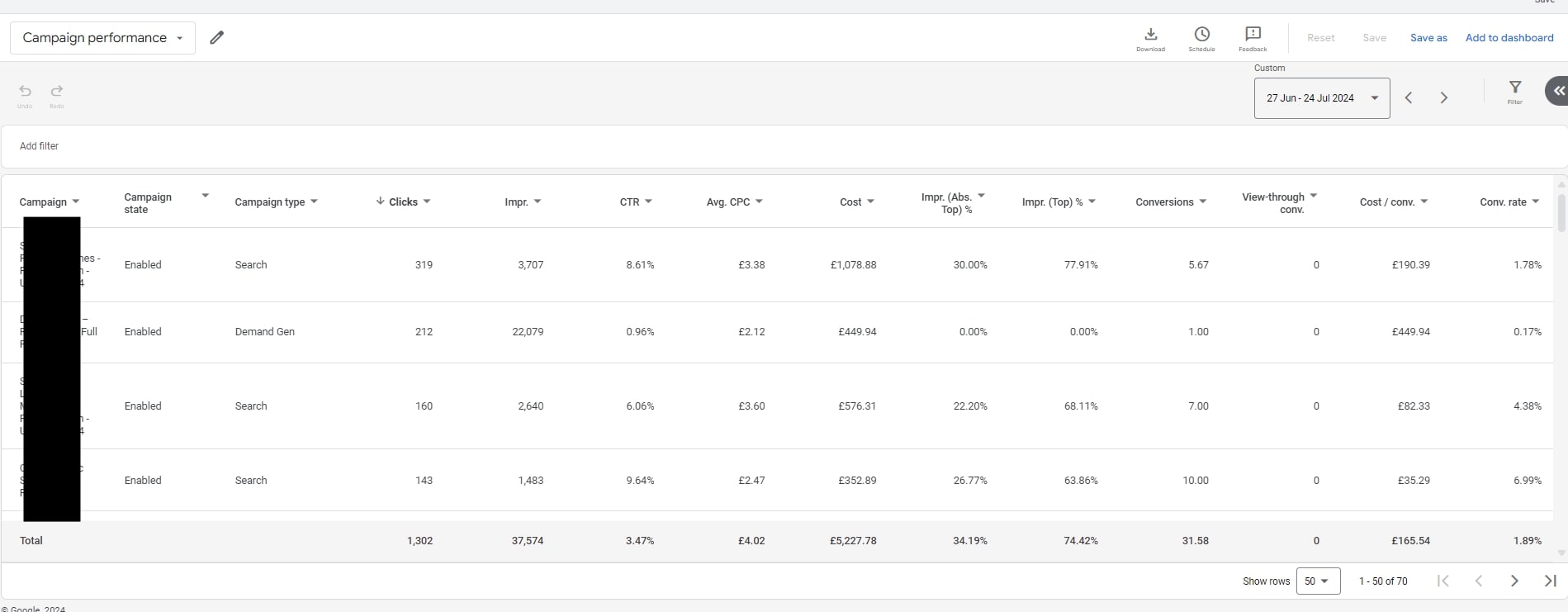
How to Optimise Your Campaign
A/B testing, also known as split testing, is a powerful method for optimising your B2B Google Ads campaign. This process involves creating two or more variations of an ad and comparing their performance to determine which version is more effective. Variables you might test include ad copy, headlines, call-to-action (CTA) phrases, and images.
By systematically testing different elements of your ads, you can identify what resonates best with your audience and refine your campaign for better results. Regular A/B testing is essential for continuous improvement and maximising your ROI.
Benefits of Leveraging Remarketing
Remarketing is a valuable strategy for B2B Google Ads, allowing you to reconnect with users who have previously interacted with your website but did not convert. By showing tailored ads to these users as they browse other websites, you can remind them of your offerings and encourage them to return and complete a purchase.
Benefits of remarketing include:
- Increased Conversion Rates: By targeting users who have already shown interest in your products or services, remarketing ads are more likely to convert.
- Improved Brand Recall: Repeated exposure to your ads helps keep your brand top-of-mind, increasing the chances that users will choose your business when they are ready to buy.
- Cost-Effective Advertising: Remarketing typically has a lower CPC compared to standard search ads, providing a cost-effective way to reach potential clients.
How to Manage Your Paid Media Budget
Effective budget management is crucial for the success of your B2B Google Ads campaign. Here are some tips for setting and adjusting your budget:
- Start Small: Begin with a modest budget to test the waters and gather data on your campaign’s performance. As you gain insights, you can gradually increase your budget.
- Monitor Performance: Regularly review your campaign’s performance metrics to identify areas where you can optimise spending. For example, if certain keywords or ad groups are performing well, consider allocating more budget to them.
- Adjust for Seasonality: Be aware of seasonal trends that may affect your industry. Adjust your budget to capitalise on peak periods and conserve spend during slower times.
- Set Daily Limits: Use daily budget limits to control your ad spend and ensure you don’t exceed your overall budget.
By carefully managing your budget, you can maximise the impact of your B2B Google Ads campaign while avoiding overspending.
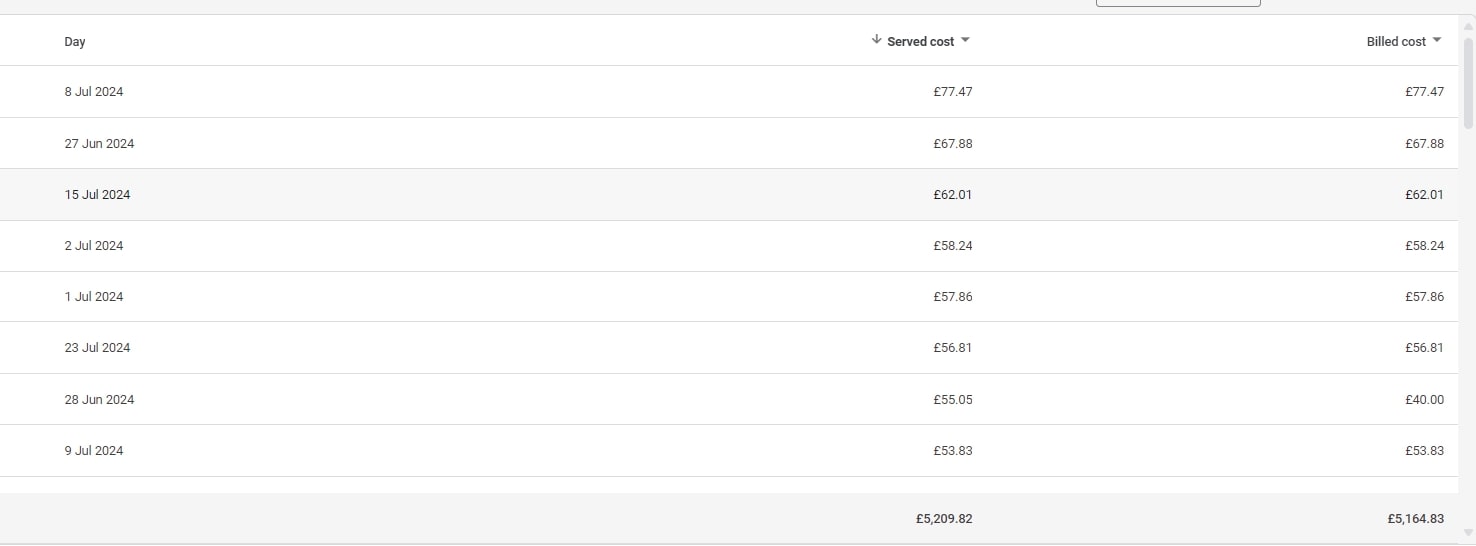
Optimising your Landing Page for Conversions
Your landing page plays a critical role in converting clicks into leads or customers. Here are some best practices for optimising your landing page:
- Clear and Compelling Headline: Your headline should immediately communicate the value proposition of your offering.
- Concise and Persuasive Copy: Use clear, concise language to explain the benefits of your product or service. Focus on addressing the needs and pain points of your target audience.
- Strong Call to Action (CTA): Include a prominent CTA that encourages users to take the desired action, such as filling out a form or downloading a resource.
- Mobile Optimisation: Ensure your landing page is mobile-friendly, as many users will access it from their smartphones.
- Fast Loading Speed: A slow-loading page can lead to high bounce rates. Optimise your landing page to load quickly to keep users engaged.
Case Studies
Examining successful B2B Google Ads campaigns can provide valuable insights and inspiration for your efforts. Here are a few examples:
- SilverCloud: By targeting specific audiences and utilising headline pinning we achieved an 89% reduction in CPA for this client.
- Advanced Dynmics: By utilising a combined SEO and Paid Search approach we helped fill the gaps on Google Search and achieved a 29% increase in website form submissions.
- Liquid Voice: By creating bespoke landing page experiences and tailored search ads we increased Liquid Voices lead generation results by over 900%.
These case studies highlight the importance of targeted keywords, compelling ad copy, and continuous optimisation in achieving success with B2B Google Ads.
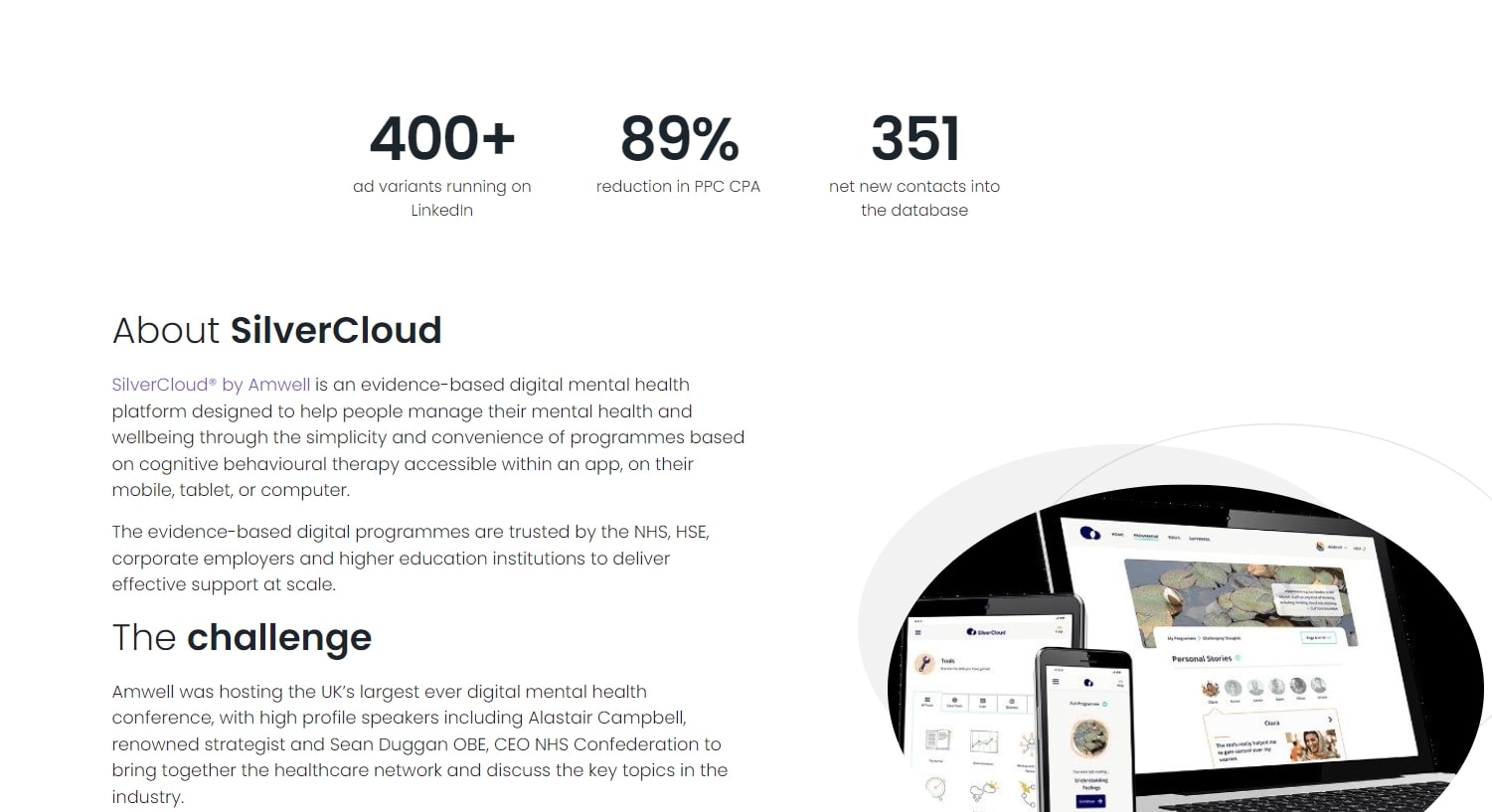
Common Google Ads Mistakes to Avoid
Avoiding common mistakes can help ensure the success of your B2B Google Ads campaign. Here are some pitfalls to watch out for:
- Neglecting Negative Keywords: Failing to use negative keywords can lead to irrelevant clicks and wasted ad spending. Regularly update your negative keyword list to exclude terms that don’t align with your business.
- Ignoring Ad Extensions: Not utilising ad extensions can limit your ad’s effectiveness. Make sure to leverage relevant ad extensions to enhance your ad’s visibility and appeal.
- Poorly Defined Target Audience: Without a clear understanding of your target audience, your ads may not reach the right people. Invest time in audience research and segmentation to ensure your ads are seen by the most relevant prospects.
- Inconsistent Messaging: Ensure your ad copy and landing page content are consistent and aligned. Inconsistent messaging can confuse users and reduce the likelihood of conversions.
- Lack of Regular Monitoring: Google Ads campaigns require ongoing monitoring and optimisation. Failing to regularly review and adjust your campaign can lead to suboptimal performance and a wasted budget.
Advanced Paid Media Strategies
Leveraging AI and machine learning can significantly enhance the performance of your B2B Google Ads campaign. Here are some advanced strategies to consider:
- Smart Bidding: Utilise Google’s Smart Bidding strategies, such as Target CPA (Cost Per Acquisition) and Target ROAS (Return on Ad Spend), which use machine learning to optimise your bids for better performance.
- Dynamic Search Ads: Automatically generate ads based on the content of your website, ensuring your ads are always relevant and up-to-date.
- Responsive Search Ads: Provide multiple headlines and descriptions, and Google will automatically test different combinations to determine the most effective ad variations.
- Audience Insights: Use Google’s audience insights to better understand your target market and refine your audience segments for more precise targeting.
By incorporating AI and machine learning into your B2B Google Ads strategy, you can achieve more efficient and effective advertising.
How to Integrate with Other Marketing Channels
Integrating your B2B Google Ads with other marketing channels can amplify your reach and effectiveness. Here are some strategies for multi-channel marketing:
- Social Media Advertising: Complement your Google Ads with targeted social media ads on platforms like LinkedIn, Facebook, and Twitter to reach a broader audience.
- Content Marketing: Use high-quality content, such as blog posts, whitepapers, and case studies, to attract and engage your target audience. Promote this content through your Google Ads campaigns.
- Email Marketing: Build an email list of leads generated from your Google Ads and nurture them with targeted email campaigns.
- SEO: Optimise your website for search engines to improve organic traffic and complement your paid advertising efforts.
A cohesive multi-channel marketing strategy ensures that your messaging is consistent and reaches your audience across various touchpoints.
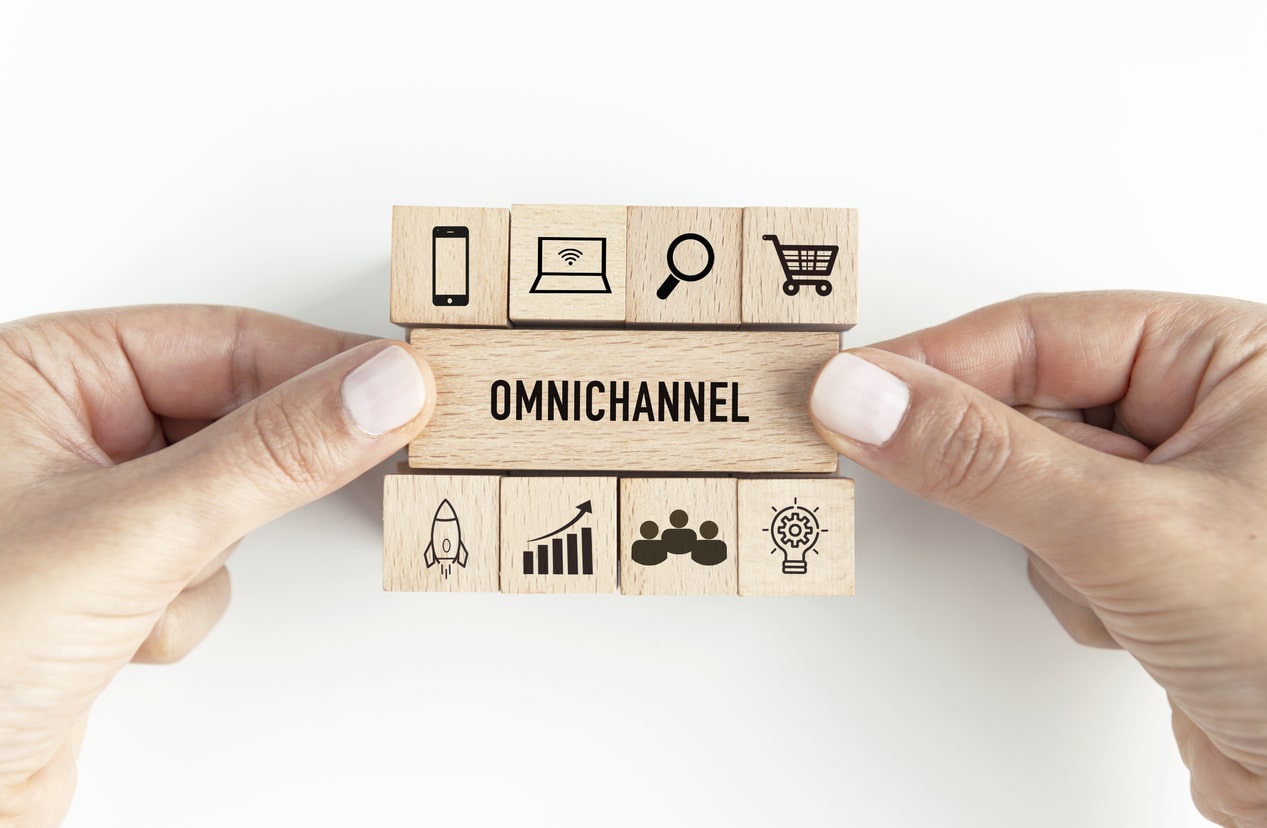
How to Adhere to Google Ads Compliance and Policies
Compliance with Google Ads policies is crucial to avoid account suspensions and ensure your ads are approved. Key policies to be aware of include:
- Prohibited Content: Google Ads does not allow ads that promote illegal products, dangerous content, or misleading claims.
- Restricted Content: Some products and services, such as healthcare and financial services, have specific restrictions and requirements.
- Editorial Standards: Ads must meet Google’s editorial standards, including correct spelling, grammar, and appropriate use of capitalisation and punctuation.
- Landing Page Requirements: Your landing page must provide a positive user experience, including transparency about your business and easy navigation.
Regularly review Google’s policies to ensure your ads comply and avoid potential issues.
Future Trends to be Aware of in B2B Google Ads
The landscape of B2B Google Ads is continually evolving. Here are some emerging trends to watch:
- Voice Search: With the rise of voice-activated devices, optimising your ads for voice search can help you reach a growing segment of users.
- Visual Search: As visual search technology advances, incorporating images and videos into your ads can enhance their appeal and effectiveness.
- AI-Driven Personalisation: Advances in AI will enable even more personalised ad experiences, increasing relevance and engagement.
- Privacy and Data Security: As privacy concerns grow, adhering to data security best practices and transparent data usage will be increasingly important.
Staying ahead of these trends can help you maintain a competitive edge and achieve continued success with your B2B Google Ads campaigns.
FAQs
How do B2B Google Ads differ from B2C ads?
B2B Google Ads target businesses rather than individual consumers. This requires a focus on reaching decision-makers and understanding longer sales cycles typical in B2B transactions.
What are long-tail keywords, and why are they important for B2B campaigns?
Long-tail keywords are specific phrases that target users closer to making a purchasing decision. They have lower search volumes but higher conversion rates, making them ideal for B2B campaigns.
What is the significance of remarketing in B2B Google Ads?
Remarketing allows you to re-engage users who have previously interacted with your website but did not convert, increasing conversion rates and improving brand recall.
How can AI and machine learning enhance my B2B Google Ads campaign?
AI and machine learning can optimise bids, generate dynamic ads, and provide audience insights, making your campaigns more efficient and effective.
What are some common mistakes to avoid in B2B Google Ads?
Common mistakes include neglecting negative keywords, ignoring ad extensions, poorly defined target audiences, inconsistent messaging, and lack of regular monitoring.
How can I integrate my B2B Google Ads with other marketing channels?
Complement your Google Ads with social media advertising, content marketing, email marketing, and SEO to create a cohesive multi-channel marketing strategy.
Are You Ready to Set Up Google Ads For Your B2B Business?
B2B Google Ads are an indispensable tool for marketing agencies looking to drive growth and achieve their business objectives. By following the strategies and best practices outlined in this ultimate guide, you can create and manage successful B2B campaigns that maximise your ROI and deliver measurable results. Continuous optimisation, leveraging advanced technologies, and integrating with other marketing channels will ensure your campaigns remain effective and competitive in the ever-evolving digital landscape. As a B2B PPC agency, we specialise in these techniques to help you achieve your marketing goals.
Feel free to contact us here.